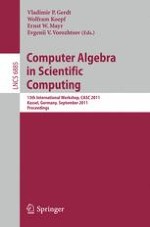This book constitutes the refereed proceedings of the 13th International Workshop on Computer Algebra in Scientific Computing, CASC 2011, held in Kassel, Germany, in September 2011. The 26 full papers included in the book were carefully reviewed and selected from numerous submissions. The articles are organized in topical sections on the development of object oriented computer algebra software for the modeling of algebraic structures as typed objects; matrix algorithms; the investigation with the aid of computer algebra; the development of symbolic-numerical algorithms; and the application of symbolic computations in applied problems of physics, mechanics, social science, and engineering.
